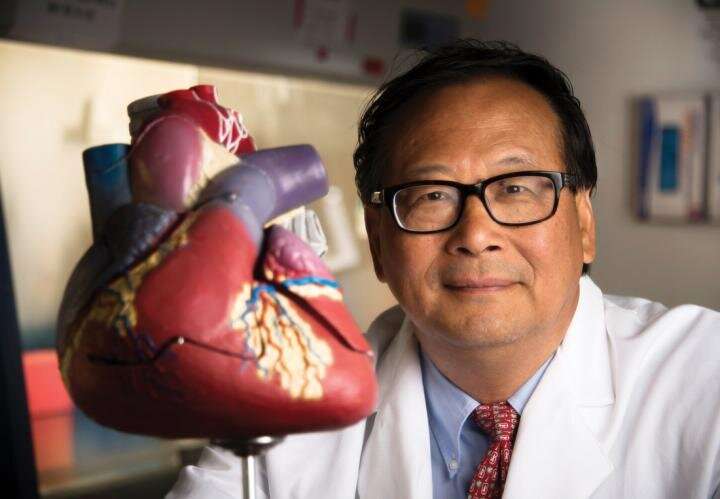
In a large-animal study, researchers have shown that heart attack recovery is aided by injection of heart muscle cells derived from human induced pluripotent stem cell line, or hiPSCs, that overexpress cyclin D2. This research, published in the journal Circulation, used a pig model of heart attacks, which more closely resembles the human heart in size and physiology, and thus has higher clinical relevance to human disease, compared to studies in mice.
An enduring challenge for bioengineering researchers is the failure of the heart to regenerate muscle tissue after a heart attack has killed part of its muscle wall. That dead tissue can strain the surrounding muscle, leading to a lethal heart enlargement.
Heart experts thus have sought to create new tissue—applying a patch of heart muscle cells or injecting heart cells—to replace damaged muscle. Similarly, they have tried to stimulate division of existing heart muscle cells near the damaged area. This current study, led by researchers at the University of Alabama at Birmingham, shows progress in both goals.
After the experimental heart attack, heart tissue around the infarction site was injected with about 30 million bioengineered human cardiomyocytes that were differentiated from hiPSCs. These cells also overexpress cyclin D2, part of a family of proteins involved in cell division.
Compared to control human cardiomyocytes, the cyclin D2-cardiomyocytes showed enhanced potency to repair the heart. They proliferated after injection, and by four weeks, the hearts had less pathogenic enlargement, reduced size of dead muscle tissue and improved heart function.
Intriguingly, the cyclin D2-cardiomyocytes stimulated not only their own proliferation, but also proliferation of existing heart muscle cells around the infarction site of the pig heart, as well as showing angiogenesis, the development of new blood vessels.
“These results suggest that the cyclin D2-cardiomyocyte transplantation may be a potential therapeutic strategy for the repair of infarcted hearts,” said study leader Jianyi “Jay” Zhang, M.D., Ph.D., the chair of Biomedical Engineering, a joint department of the UAB School of Medicine and the UAB School of Engineering.
This ability of the graft cyclin D2-cardiomyocytes to stimulate the proliferation of nearby existing heart cells suggested paracrine signaling, a type of cellular communication where a cell produces a signal that induces changes in nearby cells.
Exosomes—small blebs or tiny vesicles that are released by human or animal cells and contain proteins and RNA from the cells that release them—are one common form of paracrine signaling.
Zhang and colleagues found that exosomes that they purified from the cyclin D2-cardiomyocyte growth media indeed promoted proliferation of cultured cardiomyocytes. In addition, the treated cardiomyocytes were more resistant to programmed cell death, called apoptosis, induced by low oxygen levels. The exosomes also induced proliferation of various other cell types, including human umbilical vein endothelial cells, human vascular smooth muscle cells and 7-day-old rat cardiomyocytes that have almost undetectable proliferation.
Part of the cargo that exosomes carry are microRNAs, or miRNAs. These short pieces of RNA have the ability to interact with messenger RNA in target cells, and they are robust players of gene regulation in cells. Humans have more than 2,000 miRNAs with different RNA sequences, and these are thought to regulate a third of the genes in the genome.
So, the researchers documented which microRNAs were present in exosomes from the cyclin D2-overexpressing cardiomyocytes and in exosomes from non-overexpressing cardiomyocytes. As expected, they found differences.
Together, the exosomes from both types of cells contained 1,072 different miRNAs, and 651 were common to the two exosome groups. However, 332 miRNAs were found only in the cyclin D2-overexpressing cardiomyocytes, and 89 miRNAs were specific for the non-overexpressing cardiomyocytes. In preliminary work of characterizing the effects of specific miRNAs, one particular miRNA from the cyclin D2-overexpressing exosomes was shown to stimulate proliferation when delivered into rat cardiomyocytes.
“Thus, as the therapeutic potential of exosomes for improving cardiac function becomes more evident, combining an exosome-mediated delivery of proliferative miRNAs with transplantation of cyclin D2-overexpressing cardiomyocytes, or cell products, could become a new promising strategy for upregulating proliferation of the recipient cardiomyocytes and reducing cardiac fibrosis,” Zhang said. “Altogether, our data suggest that cardiac cell therapy, involving cardiomyocytes with enhanced proliferation capacity, may become an efficacious future strategy for myocardial repair and prevention of congestive heart failure in patients with acute myocardial infarctions.”
Jeff Hansen, University of Alabama at Birmingham

